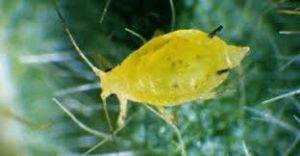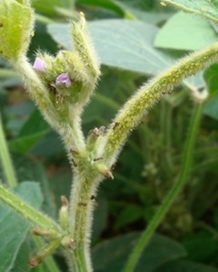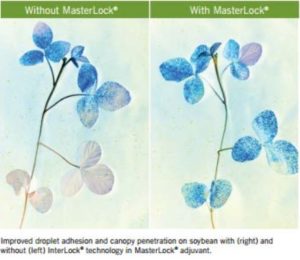
by Zach Thompson ZachT@agpartners.net
Life History:
Soybean aphids rely on two plant species, soybeans and buckthorn as hosts to complete their annual life cycle. They winter as eggs on buckthorn. In the spring they hatch and reproduce asexually, two to three generations on the buckthorn and then move to the soybean fields. Soybean aphid adults are small oval shaped bodies around 1/16th of an inch and are greenish-yellow in color.

Damage:
Soybean aphids have sucking mouth parts and damage soybeans by extracting sap or phloem. They will start by attacking the underside of the youngest emerged trifoliate. As populations build they spread throughout the plant and attack flowers, pods and stems. Low levels of aphid infestations have little or no influence on soybean growth or yield. Larger populations can heavily stress plants reducing yields by 40%. The plant will abort flowers or pods and reduce the numbers or pod or seeds per pod. Yellowed warped leaves are symptoms of plants damaged by soybeans aphids. If infestations get bad enough they will produce a honeydew which is a sugary substance they excrete.

Control:
Effective management of soybean aphids requires scouting to track aphid populations. Often, they can first be found in the later planted soybeans in the area. The University of Minnesota has shown that when temperatures are in the mid 70’s, aphid populations can double in a day and a half. The same is true if conditions are hot and wet, aphid populations can drop. There is still some debate as to what the exact threshold of soybean aphids should be. Many Midwest universities have agreed that around 250 aphids per plant is an appropriate level to justify treatment in the
R1-R5 growth stage. Once the soybean has reached R5.5 or the seed in the pod is at least 1/8th inch long in one of the pods on the upper 4 nodes. Numerous insecticides are effective and labeled for use against the soybean aphids. The timing and spray coverage is just as important as the insecticide.

Consider using a flat fan nozzle with a minimum of 20 GPA and higher spray pressure (40-80 psi) to improve spray coverage. MasterLock® is an important adjuvant to be added to the tank to improve canopy penetration and maintain droplet size. Ahpid spraying is a great time to add a fungicide to maintain and protect your investment in the crop.
Please talk with your Ag Partners agronomist to determine the best course of action for your fields.


